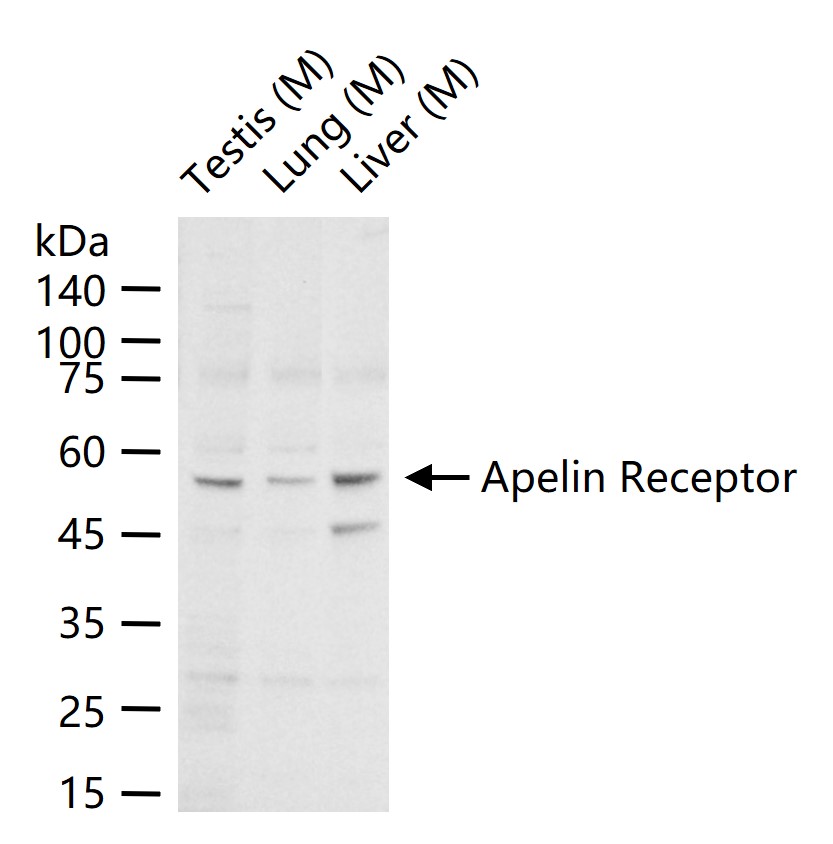Apelin Receptor Rabbit pAb
Apelin Receptor Rabbit pAb
- 产品详情
- 实验流程
- 背景知识
Application
| WB |
|---|---|
| Primary Accession | P35414 |
| Reactivity | Mouse |
| Host | Rabbit |
| Clonality | Polyclonal |
| Calculated MW | 42660 Da |
| Physical State | Liquid |
| Immunogen | KLH conjugated synthetic peptide derived from human Apelin receptor |
| Epitope Specificity | 41-140/380 |
| Isotype | IgG |
| Purity | affinity purified by Protein A |
| Buffer | 0.01M TBS (pH7.4) with 1% BSA, 0.02% Proclin300 and 50% Glycerol. |
| SUBCELLULAR LOCATION | Cell membrane. |
| SIMILARITY | Belongs to the G-protein coupled receptor 1 family. |
| Important Note | This product as supplied is intended for research use only, not for use in human, therapeutic or diagnostic applications. |
| Background Descriptions | This gene encodes a member of the G protein-coupled receptor gene family. The encoded protein is related to the angiotensin receptor, but is actually an apelin receptor that inhibits adenylate cyclase activity and plays a counter-regulatory role against the pressure action of angiotensin II by exerting hypertensive effect. It functions in the cardiovascular and central nervous systems, in glucose metabolism, in embryonic and tumor angiogenesis and as a human immunodeficiency virus (HIV-1) coreceptor. Two transcript variants resulting from alternative splicing have been identified. [provided by RefSeq |
| Gene ID | 187 |
|---|---|
| Other Names | Apelin receptor, Angiotensin receptor-like 1, G-protein coupled receptor APJ, G-protein coupled receptor HG11, APLNR (HGNC:339), AGTRL1, APJ |
| Target/Specificity | Widely expressed in the brain, in glial cells, astrocytes and neuronal subpopulations, as well as in the spleen, thymus, ovary, small intestine and colon. |
| Dilution | WB=1:500-2000 |
| Storage | Store at -20 °C for one year. Avoid repeated freeze/thaw cycles. When reconstituted in sterile pH 7.4 0.01M PBS or diluent of antibody the antibody is stable for at least two weeks at 2-4 °C. |
| Name | APLNR (HGNC:339) |
|---|---|
| Synonyms | AGTRL1, APJ |
| Function | G protein-coupled receptor for peptide hormones apelin (APLN) and apelin receptor early endogenous ligand (APELA/ELA), that plays a role in the regulation of normal cardiovascular function and fluid homeostasis (PubMed:11090199, PubMed:22810587, PubMed:25639753, PubMed:28137936, PubMed:35817871, PubMed:38428423). When acting as apelin receptor, activates both G(i) protein pathway that inhibits adenylate cyclase activity, and the beta-arrestin pathway that promotes internalization of the receptor (PubMed:11090199, PubMed:25639753, PubMed:28137936, PubMed:35817871, PubMed:38428423). APLNR/APJ also functions as mechanoreceptor that is activated by pathological stimuli in a G-protein-independent fashion to induce beta-arrestin signaling, hence eliciting cardiac hypertrophy (PubMed:22810587, PubMed:38428423). However, the presence of apelin ligand blunts cardiac hypertrophic induction from APLNR/APJ on response to pathological stimuli (PubMed:22810587, PubMed:38428423). Plays a key role in early development such as gastrulation, blood vessels formation and heart morphogenesis by acting as a APELA receptor (By similarity). May promote angioblast migration toward the embryonic midline, i.e. the position of the future vessel formation, during vasculogenesis (By similarity). Promotes sinus venosus (SV)-derived endothelial cells migration into the developing heart to promote coronary blood vessel development (By similarity). Also plays a role in various processes in adults such as regulation of blood vessel formation, blood pressure, heart contractility and heart failure (PubMed:25639753, PubMed:28137936). |
| Cellular Location | Cell membrane. Note=After exposure to apelin (APLN), internalized from the cell surface into an endosomal recycling compartment, from where it is recycled to the cell membrane (By similarity). After exposure to apelin receptor early endogenous ligand (APELA), internalized from the cell surface into an endosomal recycling compartment, from where it is recycled to the cell membrane (PubMed:25639753). {ECO:0000250|UniProtKB:Q9JHG3, ECO:0000269|PubMed:25639753} |
| Tissue Location | Expressed in heart, brain, kidney, stomach, spleen, thymus, lung, ovary, small intestine and colon, adipose tissues and pancreas (PubMed:25639753, PubMed:8294032). Expressed in glial cells, astrocytes and neuronal subpopulations (PubMed:8294032). Expressed in embryonic (ESCs) and induced (iPSCs) pluripotent stem cells (PubMed:25639753). |
For Research Use Only. Not For Use In Diagnostic Procedures.
Provided below are standard protocols that you may find useful for product applications.
BACKGROUND
This gene encodes a member of the G protein-coupled receptor gene family. The encoded protein is related to the angiotensin receptor, but is actually an apelin receptor that inhibits adenylate cyclase activity and plays a counter-regulatory role against the pressure action of angiotensin II by exerting hypertensive effect. It functions in the cardiovascular and central nervous systems, in glucose metabolism, in embryonic and tumor angiogenesis and as a human immunodeficiency virus (HIV-1) coreceptor. Two transcript variants resulting from alternative splicing have been identified. [provided by RefSeq
REFERENCES
O'Dowd B.F.,et al.Gene 136:355-360(1993).
Eggerickx D.,et al.Submitted (JUN-1995) to the EMBL/GenBank/DDBJ databases.
终于等到您。ABCEPTA(百远生物)抗体产品。
点击下方“我要评价 ”按钮提交您的反馈信息,您的反馈和评价是我们最宝贵的财富之一,
我们将在1-3个工作日内处理您的反馈信息。
如有疑问,联系:0512-88856768 tech-china@abcepta.com.























 癌症的基本特征包括细胞增殖、血管生成、迁移、凋亡逃避机制和细胞永生等。找到癌症发生过程中这些通路的关键标记物和对应的抗体用于检测至关重要。
癌症的基本特征包括细胞增殖、血管生成、迁移、凋亡逃避机制和细胞永生等。找到癌症发生过程中这些通路的关键标记物和对应的抗体用于检测至关重要。 为您推荐一个泛素化位点预测神器——泛素化分析工具,可以为您的蛋白的泛素化位点作出预测和评分。
为您推荐一个泛素化位点预测神器——泛素化分析工具,可以为您的蛋白的泛素化位点作出预测和评分。 细胞自噬受体图形绘图工具为你的蛋白的细胞受体结合位点作出预测和评分,识别结合到自噬通路中的蛋白是非常重要的,便于让我们理解自噬在正常生理、病理过程中的作用,如发育、细胞分化、神经退化性疾病、压力条件下、感染和癌症。
细胞自噬受体图形绘图工具为你的蛋白的细胞受体结合位点作出预测和评分,识别结合到自噬通路中的蛋白是非常重要的,便于让我们理解自噬在正常生理、病理过程中的作用,如发育、细胞分化、神经退化性疾病、压力条件下、感染和癌症。






